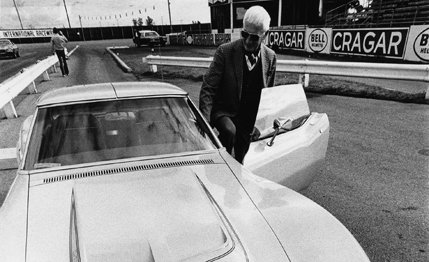“Maybe for street engine I make mistake — aluminum heads are expensive and that weight doesn’t matter on the street.” But he’s not going to compromise the performance just to take money out. And he has harsh words for the “bean counters” who occasionally eliminate a worthwhile option or feature. The L46 for example. Until this year you could buy a 350 cu.in. 350-hp engine with a hydraulic camshaft that had very nearly the performance of the LT1 but was also compatible with air conditioning. And you could buy it for about $150 compared to $483 for the LT1. “Redundant,” decided the bean counters and axed it off the list. Duntov thinks otherwise.
As for the engines that have survived, they have clearly suffered, not from the bean counters but at the hands of the emission control engineers. Dropping the compression ratio has pruned about 5% off the horsepower curves of all the Corvette engines and it shows up on the drag strip. The LS6 is fast, make no mistake — 13.8 seconds at 104.65 mph for the quarter — but the three 2-bbl. 435-hp 427 tested two years ago (September ’69) turned 106.8 mph. Axle ratios enter in here. While the 427 had a 3.70, the LS6 was hobbled with a 3.36 which not only means that you just hit third gear before the speed traps but makes getting a clean start more difficult.
The LS6 will definitely produce better times with a higher numerical axle ratio. And with a freer exhaust system. According to Duntov, 50 horsepower is lost in the mufflers. That, however, is life. You have to have mufflers on the street. California laws say they have to be quiet ones and the LS6’s are — stifled even. The pulses are still distinct — when each cylinder is pumping out over 50 horsepower they couldn’t be otherwise — but they’re muted. Giants in padded cells. (Chevrolet used to offer a chambered-pipe outside exhaust system that cost about 10 fewer horsepower than the mufflers but that’s too loud now….)
|
|
As you would expect, the personalities of the LS5 and the LT1 are worlds apart. In performance however, they are neck and neck. With the 454 automatic, just stand on it and go. Even though it is 305 lbs. heavier than the LT1, it reaches the end of the quarter about 0.3 seconds sooner. Like the LS6, the LT1 is very difficult to launch properly — the close-ratio gear box is not really suitable for standing start acceleration — so that even though the smaller engine Corvette is traveling faster at the end, it takes longer to get there. Naturally, the 270-hp model takes the longest of all to get there — 15.55 seconds at 90.36 mph — and with its power-robbing options, it should be the slowest possible Corvette.
All of the Corvettes would be quicker if a cold air induction system were available. The discontinued L88 had one — a backwards facing hood scoop — but it also let a lot of engine noise seep out which California didn’t like — and it was in conflict with the emission control hardware — so it was killed. (Duntov wouldn’t admit to any plans to revive it.) Cold air to the carburetor is particularly helpful in a Corvette because it has the least underhood area of any 8-cylinder Chevrolet — which means it suffers the most from high underhood temperatures. You can see it from the drag strip results. Each succeeding run is slower than the previous one until a final equilibrium is reached, usually 1-2 mph slower than the first run following a cool-off period. The high engine compartment temperatures are also transferred into the cockpit. Considerable effort has been made to ventilate the underhood area more effectively, the front fender vents help, but not enough to make the passenger compartment comfortable in hot weather. So unless you are intent on straight-line performance, we recommend air conditioning.
View Photos
View Photos


Leave a Reply